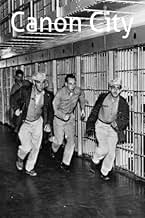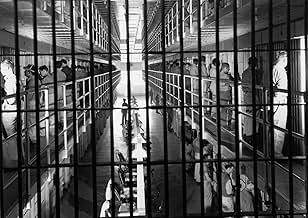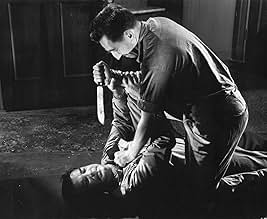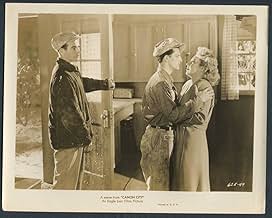Adicionar um enredo no seu idiomaTwelve inmates plan a prison break from the Colorado State Penitentiary but one of them reluctantly joins the group.Twelve inmates plan a prison break from the Colorado State Penitentiary but one of them reluctantly joins the group.Twelve inmates plan a prison break from the Colorado State Penitentiary but one of them reluctantly joins the group.
- Direção
- Roteirista
- Artistas
Reed Hadley
- Narrator
- (narração)
Avaliações em destaque
"Canon City" (spelled c-a-n-o-n but pronounced as "canyon") is an example of a type of film prominent in the late 1940s: the docudrama. Usually these films had a noirish sensibility and were almost always about gritty subject matter. They were part documentary and part fiction -- filmed on location in actual locales with objective third-party narration, stripped-down production values and a journalistic focus on presenting events matter-of-factly and without superfluous emotion.
"Canon City" tells the story of a famous prison break from a Colorado penitentiary. The first part of the film gives us a tour of the prison and introduces us to men who were the actual inmates at the time the movie was filmed; the chief warden of the prison likewise plays the warden in the movie. After this extended prologue, actors take over to portray the actual escape and the subsequent manhunt that put families living nearby at risk as the escaped cons used their homes as hideouts.
The film is very spare and terse, which is not a criticism from me. It's a refreshing break from the Hollywood melodrama that characterized glossier, studio-backed movies at the time. But the film is SO bare bones that it's difficult to feel strongly one way or the other about it. Its bargain-bin look is a nice compliment to the story it's telling, but one can't help but miss the style that artists who came with a higher price tag might have brought to the same material.
Grade: B
"Canon City" tells the story of a famous prison break from a Colorado penitentiary. The first part of the film gives us a tour of the prison and introduces us to men who were the actual inmates at the time the movie was filmed; the chief warden of the prison likewise plays the warden in the movie. After this extended prologue, actors take over to portray the actual escape and the subsequent manhunt that put families living nearby at risk as the escaped cons used their homes as hideouts.
The film is very spare and terse, which is not a criticism from me. It's a refreshing break from the Hollywood melodrama that characterized glossier, studio-backed movies at the time. But the film is SO bare bones that it's difficult to feel strongly one way or the other about it. Its bargain-bin look is a nice compliment to the story it's telling, but one can't help but miss the style that artists who came with a higher price tag might have brought to the same material.
Grade: B
A fine prison break movie from Crane Wilbur by way of Eagle-Lion Pictures, Canon City is a very good, tense film, based on a true incident, about a group of men who break of of the eponymous state prison, where the movie was also filmed. There is particular emphasis on two escapees, a reluctant one who is basically a decent guy, and a more aggressive one, who isn't. As portrayed by Scott Brady and Jeff Corey these characters come to life and compel our interest, and in Brady's case sympathy.
As photographed by the masterful John Alton, the picture is a pleasure to watch, as Mr. Alton was a master of light and shadow, and is obviously in his element with this dark story. He brightens things up in the end with a snowstorm, which enables the picture to end on a grace note, and even a feeling of optimism, not wholly justified by the events we have just witnessed.
As photographed by the masterful John Alton, the picture is a pleasure to watch, as Mr. Alton was a master of light and shadow, and is obviously in his element with this dark story. He brightens things up in the end with a snowstorm, which enables the picture to end on a grace note, and even a feeling of optimism, not wholly justified by the events we have just witnessed.
For anyone who enjoys mid-20th century movies, "Canon City" is a perfect choice. I had the good fortune to watch this movie in the wee hours of the morning, when old black-and-white movies are best viewed. Tension abounds in this surprisingly gripping story. That it's based on real events and filmed on location is a plus. If you have ever visited the Royal Gorge Bridge and tram in Colorado, you will enjoy the cat-and-mouse chase scene near the end of the movie. The women are heroic in this film, much more so than the men. With their calming words, warm food, hot cocoa, and hammer-wielding ways, they demonstrate courage in the face of danger. "Star Trek" fans will find a treat in the prisoner known as Smalley. He is played by DeForest Kelley, best known to Trekkies everywhere as Dr. Leonard "Bones" McCoy. "Canon City" is a thoroughly enjoyable film. Catch it on late-night TV if you can.
Directed by veteran film-maker Crane Wilbur this rousing prison story is based on actual events that occurred at the Canon City penitentiary in Colorado in 1947.Newcomer Scott Brady is excellent as a convict who,caught up in events, must join in with eleven other escapees.As the fast-paced film-noir unfolds,each event is chronicled by that wonderful narrator Reed Hadley in semi-documentary fashion.A fine cast of character actors round out the cast; Jeff Corey as the ruthless convict leader,Stanley Clements,Robert Bice,and ( against type) Whit Bissell as a nervous killer.Actress Mabel Paige is particularly good as a very brave housewife.This film is another great example of Eagle-Lion pictures during that corporation's short run.
This movie proudly bears the label of a semi-documentary and comes complete with the usual Foreword about all the incidents being portrayed exactly as they happened, and all photographed on their actual locations, using real warders, guards and convicts, etc.
Personally, I doubt that the movie was shot in its entirety inside the actual prison there's even a credit for 2nd unit direction and photography. But be this as it may, the studio material is certainly extremely well integrated with the location footage. Credit for this achievement is mostly due to John Alton, whose masterful photography makes Canon City must watching for connoisseurs. True, Alton's work here is less tantalizing than usual as he was required to match up his shots with Strenge's rather dull location work. Nonetheless, there are still more than a few indications (the profile silhouette on Brady's face) of genius behind the camera.
Crane Wilbur's screenplay is less praiseworthy, but typical of that writer's detached, tabloid newspaper-style approach. He loves the sort of narrated rhetoric employed by contemporary newsreel commentators (Reed Hadley does a good job here with the actual narration), but fortunately his dialogue is less flowery and more realistic.
Generally Wilbur's direction rates as rather dull, but here his handling is even occasionally inventive, although his experiments are not always successful (as for example in the oddly oblique use of the first-person camera right at the beginning, with the on-screen characters swapping words with the disembodied narrator).
In all, however, the film emerges as a reasonably engrossing prison melodrama, convincingly acted (except oddly by the non-professionals), compellingly photographed, and tautly written. Despite its foregone conclusion, the storyline does build up a moderate amount of excitement and tension.
Personally, I doubt that the movie was shot in its entirety inside the actual prison there's even a credit for 2nd unit direction and photography. But be this as it may, the studio material is certainly extremely well integrated with the location footage. Credit for this achievement is mostly due to John Alton, whose masterful photography makes Canon City must watching for connoisseurs. True, Alton's work here is less tantalizing than usual as he was required to match up his shots with Strenge's rather dull location work. Nonetheless, there are still more than a few indications (the profile silhouette on Brady's face) of genius behind the camera.
Crane Wilbur's screenplay is less praiseworthy, but typical of that writer's detached, tabloid newspaper-style approach. He loves the sort of narrated rhetoric employed by contemporary newsreel commentators (Reed Hadley does a good job here with the actual narration), but fortunately his dialogue is less flowery and more realistic.
Generally Wilbur's direction rates as rather dull, but here his handling is even occasionally inventive, although his experiments are not always successful (as for example in the oddly oblique use of the first-person camera right at the beginning, with the on-screen characters swapping words with the disembodied narrator).
In all, however, the film emerges as a reasonably engrossing prison melodrama, convincingly acted (except oddly by the non-professionals), compellingly photographed, and tautly written. Despite its foregone conclusion, the storyline does build up a moderate amount of excitement and tension.
Você sabia?
- CuriosidadesFilm debut of Scott Brady.
- Erros de gravaçãoImmediately after the prison break, there's a shot of a crowd of people leaving a movie theatre, with Abbott & Costello in 2 Prontos de Sorte (1948) (another Eagle-Lion release) prominently displayed on the readerboard. Only problem is, the break took place 30 December 1947, and The Noose Hangs High wasn't released until the end of the following April.
- ConexõesReferenced in Let's Go to the Movies (1949)
Principais escolhas
Faça login para avaliar e ver a lista de recomendações personalizadas
Detalhes
Bilheteria
- Orçamento
- US$ 424.000 (estimativa)
- Tempo de duração1 hora 22 minutos
- Cor
- Proporção
- 1.37 : 1
Contribua para esta página
Sugerir uma alteração ou adicionar conteúdo ausente























